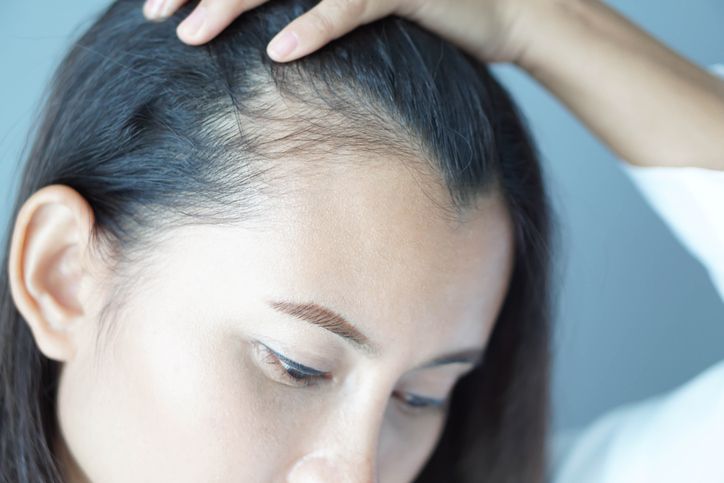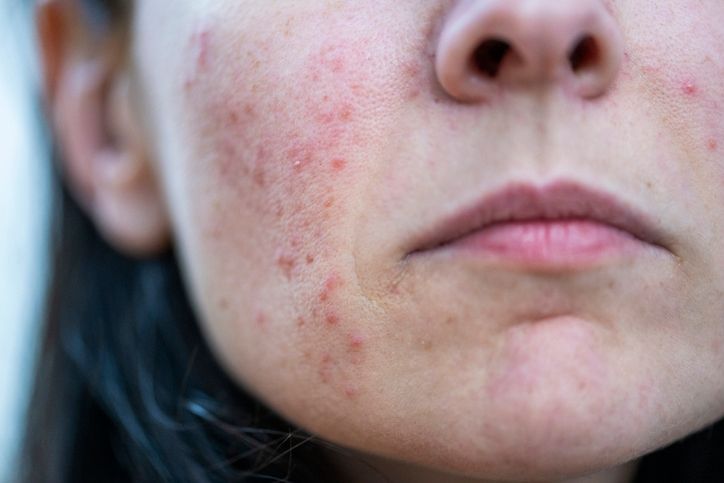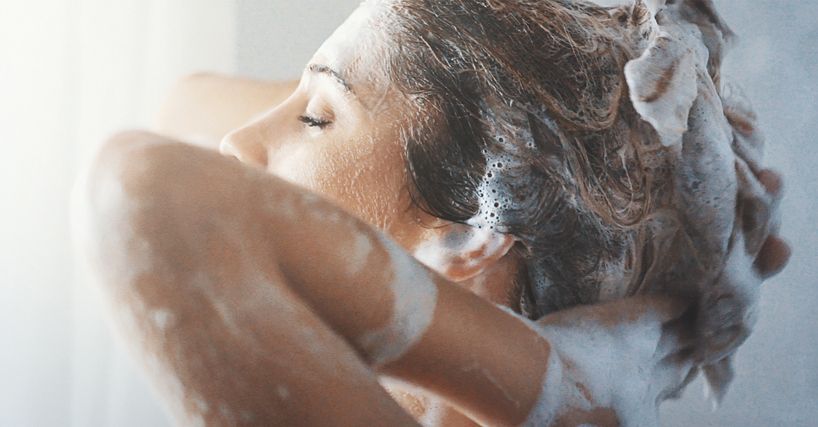
Author: Natalie Ng|Updated: 8 May 2025
Frontal baldness, or a receding hairline, can be frustrating, especially when it feels like your hairline is slowly creeping back. It's a common issue that many people face, whether due to male pattern baldness or female pattern hair loss. Understanding the causes of this condition and taking early action can make a big difference in slowing down or even preventing further hair loss. Frontal baldness is often linked to androgenetic alopecia, a hereditary condition that affects both men and women. In men, it typically causes the hairline to recede, while in women, it can lead to thinning hair across the scalp. The loss of hair at the front of the head is usually gradual, but without treatment, it can worsen over time. There are various factors that contribute to frontal hair loss, such as hormonal changes, genetics, and certain lifestyle habits. Stress, poor diet, and even certain hair styling practices can impact the health of your hair follicles, accelerating the loss. It's important to address these issues early on, especially since early treatment can help maintain and promote hair growth. Keep reading to explore some practical solutions to stop frontal baldness before it gets worse.

Early Signs of Frontal Hair Loss

Recognizing the early signs of frontal hair loss is key to stopping further hair loss before it becomes more noticeable. One of the first things you'll notice is your hairline beginning to recede at the temples, often forming an M-shaped pattern. This gradual change can be subtle at first, but over time, it becomes more pronounced and harder to ignore.
1. Increased Hair Shedding
Another early sign of frontal hair loss is increased hair shedding. You may notice more hair than usual in your brush or when washing your hair. This can be a sign that your hair follicles are not as active, and the growth phase of your hair growth cycle is shortening.
2. Thinning and Finer Hair
As the hair follicles shrink, the hair along your frontal hairline can become noticeably thinner. The strands may also become finer and shorter, signaling that hair growth is slowing down. You might even notice your hair texture changing, with strands feeling more brittle or difficult to style.
3. Changes in Scalp Visibility
If your frontal hairline is receding, your scalp may become more visible, especially in bright lighting. This is often the result of frontal hair loss, where the area around your forehead becomes less covered by hair.
Regularly taking photos of your hairline can help you track any gradual changes over time. If you spot these signs, it might be time to consider consulting a dermatologist. They can help identify the cause of your frontal baldness and suggest effective treatments for hair loss based on your specific condition.
Identifying Normal vs. Excessive Shedding
Identifying normal vs. excessive shedding is crucial in determining the underlying cause of hair loss. On average, people lose around 50-100 hairs per day, which is a normal part of the hair growth cycle. However, if you notice significantly more hair in your brush, shower drain, or on your pillow, it might be a sign of excessive shedding. This can be an early indicator of conditions like male pattern baldness, female pattern hair loss, or other types of hair loss.
To determine if your shedding is excessive, monitor your hair loss over a period of time. Look for signs such as thinning hair, a receding hairline, or bald patches. Keeping a hair loss diary or taking regular photos of your hairline can help track changes. If you suspect excessive shedding, it’s essential to consult a dermatologist or healthcare professional for a proper evaluation and diagnosis. Early detection and treatment can make a significant difference in managing hair loss and promoting hair growth.
Seasonal Shedding Patterns
Seasonal shedding patterns are a common phenomenon where people experience increased hair shedding during certain times of the year. This can be due to various factors such as changes in temperature, humidity, and hormone levels. For instance, some individuals may notice more hair loss during the spring and fall seasons, while others might experience it during the winter months.
Understanding your seasonal shedding patterns can help you take preventive measures to reduce hair loss and promote hair growth. During these periods, consider using gentle hair care products that nourish your scalp and hair. Reducing the use of heat styling tools like curling irons and blow dryers can also minimize damage. Additionally, maintaining a healthy diet rich in vitamins and minerals can support your hair’s health and resilience. By being proactive, you can manage seasonal shedding more effectively and maintain healthier hair year-round.

Stop Frontal Baldness With These Solutions :

1. Essential Vitamins and Minerals for Hair Health
Maintaining healthy hair growth requires a balanced intake of specific vitamins and minerals that support the overall function of your hair follicles. The right nutrients can help improve your hair's strength, thickness, and growth, while deficiencies in certain vitamins and minerals can lead to thinning hair and accelerated hair loss. Understanding which nutrients are essential can help you make smarter dietary choices and adopt the best supplements to promote hair growth.
Biotin and B-Complex Benefits
Biotin, also known as vitamin B7, is often associated with healthy hair growth. Biotin helps produce keratin, the protein that makes up your hair. B-complex vitamins, which include biotin, work together to nourish hair follicles and support healthy hair growth. When you maintain sufficient levels of biotin, you may notice stronger hair, reduced shedding, and improved overall hair health. Deficiency in biotin can result in thinning hair or excessive hair loss, particularly around the frontal hairline.
To ensure you get enough biotin, include foods like eggs, nuts, and leafy greens in your diet. These are rich sources of biotin and other B vitamins that your hair needs. If you're concerned about your intake, consider speaking to a healthcare provider before starting a biotin supplement to avoid potential overdosing.
Iron and Zinc Essentials
Iron and zinc are critical minerals for hair health and the prevention of frontal baldness. Iron is essential for carrying oxygen to your hair follicles, ensuring they remain nourished and capable of supporting hair growth. Zinc, on the other hand, helps regulate the hormones that influence hair growth and ensures that your follicles function properly. Zinc also plays a role in protein synthesis, crucial for building the hair shaft.
A lack of iron can lead to hair loss, particularly in women, due to the higher risk of iron deficiency. Iron-rich foods such as lean meats, spinach, and legumes can help address this deficiency. Zinc, found in foods like pumpkin seeds, oysters, and beans, helps maintain a healthy hair cycle and supports the repair of hair follicles.
Vitamin D's Hair Connection
Vitamin D plays a crucial role in maintaining a healthy scalp and promoting hair growth. Adequate levels of vitamin D can stimulate hair follicles, encouraging new hair to grow and preventing hair shedding. When vitamin D is deficient, you may notice more hair loss, particularly around the frontal hairline, as the growth phase of your hair growth cycle is disrupted.
Getting enough vitamin D is as simple as spending time outdoors for about 15-20 minutes each day or incorporating dietary sources such as fatty fish, eggs, and fortified foods. Supplements are another option, but it's essential to monitor your vitamin D levels and avoid excessive amounts. A doctor can recommend the best approach based on your needs.
By maintaining a balanced intake of these essential nutrients, you can promote healthy hair growth, reduce the chances of hair thinning, and prevent further frontal baldness. Regularly incorporating these vitamins and minerals into your diet can help your hair follicles perform optimally, supporting long-term hair health.
2. FDA-Approved Medications That Combat Hair Loss
When it comes to treating frontal baldness, there are a few FDA-approved medications that have shown to be effective. These treatments are scientifically backed and can help slow down hair loss, promote hair growth, and maintain the hairline. While there are many over-the-counter products that claim to help, only two medications have been clinically proven to address the root causes of male pattern baldness and frontal hair loss.
Minoxidil
Minoxidil is one of the most widely used treatments for male pattern hair loss and is available over the counter in both liquid and foam formulations. It works by improving blood circulation to the hair follicles, which can help extend the growth phase of the hair growth cycle. This allows your hair to grow thicker and stronger, reducing shedding in the process.
Minoxidil should be applied directly to the affected area of your scalp, typically twice a day. It's important to apply it consistently for at least three to four months to see noticeable results. While minoxidil can be effective for many individuals, it does not cure frontal baldness, and its benefits will only last as long as the treatment is continued. Some people may experience mild scalp irritation or dryness, so it's important to monitor how your skin reacts to the treatment.
Finasteride
Finasteride, another FDA-approved medication, works by blocking the conversion of testosterone into dihydrotestosterone (DHT), the hormone that contributes to male pattern baldness. DHT shrinks hair follicles and shortens the hair growth cycle, leading to thinning hair and a receding hairline. By reducing DHT levels, finasteride helps preserve hair and may even stimulate new growth in some cases.
Finasteride is taken orally, usually once a day, and can be an effective option for both frontal baldness and male pattern hair loss. It is important to note that finasteride requires a prescription and may come with some side effects, such as reduced libido or erectile dysfunction. These side effects are rare but should be discussed with a healthcare provider before starting the medication.
Both minoxidil and finasteride are proven treatments for frontal hair loss, but they require consistent use for effective results. It's also important to keep in mind that these medications may not work for everyone, and it's always a good idea to consult a healthcare provider before starting any treatment regimen.
3. Natural and Herbal Remedies for Stronger Hair
While pharmaceutical treatments are effective, many people prefer to try natural alternatives. Several herbal and botanical remedies have gained popularity for their potential to support hair health and possibly reduce hair loss. Though the scientific evidence behind these remedies varies, some natural ingredients may help improve hair quality and contribute to hair growth over time.
Saw Palmetto
Saw palmetto is a popular herb that is believed to block the production of DHT, a hormone responsible for shrinking hair follicles in male pattern baldness. This makes saw palmetto a potential natural alternative to finasteride, which also works by blocking DHT. While research on saw palmetto’s effectiveness for frontal baldness is still limited, it has shown promise in preventing hair loss and supporting hair regrowth in some individuals.
Saw palmetto can be taken in supplement form or applied topically in the form of oils or shampoos. It's important to keep in mind that the effects of saw palmetto can be more gradual compared to FDA-approved treatments, so patience is necessary.
Rosemary Oil
Rosemary oil is another popular remedy for improving scalp circulation and promoting hair growth. Some studies suggest that rosemary oil can stimulate hair follicles and increase blood flow to the scalp, which may lead to thicker, healthier hair. This oil can be massaged into the scalp, where it can help reduce hair shedding and thinning hair.
To use rosemary oil, simply mix a few drops with a carrier oil (like coconut or olive oil) and gently massage it into your scalp. Let it sit for at least 30 minutes before washing it out with a gentle shampoo.
Pumpkin Seed Oil
Pumpkin seed oil contains various nutrients, including zinc and essential fatty acids, that are beneficial for hair health. Some research suggests that pumpkin seed oil may help reduce inflammation in the scalp and promote hair regrowth by improving follicle health. It can be used as a supplement or applied topically to nourish the scalp and strengthen existing hair.
Though natural remedies like saw palmetto, rosemary oil, and pumpkin seed oil can support hair health, they are most effective when used in combination with other treatments like FDA-approved medications or lifestyle changes.
4. Scalp Care and Hair Washing Best Practices
Proper scalp care is essential for maintaining healthy hair and preventing further hair loss. Regular hair washing, combined with gentle scalp care, can improve hair follicle health and keep your scalp clean, reducing the risk of scalp hair loss. However, certain hair washing practices can also harm your hair, especially if done incorrectly.
Wash Your Hair Regularly (But Not Too Often)
While washing your hair is important, over-washing can strip your scalp of natural oils that help nourish your hair. Aim to wash your hair two to three times per week, depending on your hair type and lifestyle. Use lukewarm water instead of hot water, as hot water can irritate the scalp and damage the hair follicles, contributing to hair thinning and breakage.
Choose Gentle, Sulfate-Free Shampoos
Sulfates, which are found in many shampoos, can be harsh on the scalp and hair, stripping natural oils and potentially irritating the skin. Opt for sulfate-free shampoos that are gentle on your hair and scalp. Look for products that contain ingredients like aloe vera, argan oil, or biotin, which can nourish and strengthen your hair. Always follow up with a moisturizing conditioner to keep your hair hydrated and prevent dryness.
Scalp Massage
Massaging your scalp during hair washing can help improve blood circulation to your hair follicles, promoting hair growth and potentially reducing frontal hair loss. Use your fingertips to massage your scalp in gentle, circular motions for a few minutes each time you wash your hair. This will help stimulate the hair follicles and may encourage new growth.
5. Lifestyle Changes to Prevent Further Hair Loss
Certain lifestyle habits can have a significant impact on your hair's health. Making strategic changes to your daily routine can reduce the progression of frontal baldness and help you maintain existing hair. Stress, poor diet, and unhealthy habits can accelerate hair loss, while positive changes can promote hair growth and improve the health of your hair follicles.
Stress Management
Chronic stress is a major contributor to hair loss because it increases cortisol levels in the body, which can negatively affect hair follicles. Managing stress through regular exercise, meditation, or yoga can help lower cortisol levels and create an environment more conducive to healthy hair growth. Even short periods of deep breathing exercises can have a positive impact on both your mental health and hair health.
Quit Smoking
Smoking is linked to poor circulation, which can restrict blood flow to the scalp and deprive hair follicles of essential nutrients. By quitting smoking, you can improve blood flow and support healthier hair growth. Studies show that smoking can exacerbate conditions like androgenetic alopecia and contribute to male pattern baldness.
Limit Alcohol Consumption
Excessive alcohol consumption can negatively affect your hair health by lowering zinc levels and disrupting hormone balance. Zinc is an essential mineral for healthy hair follicles, and a deficiency can contribute to hair loss. Limiting alcohol intake and ensuring you get enough zinc-rich foods in your diet can support better hair growth and prevent further hair thinning.
Balanced Diet
A well-rounded diet rich in essential vitamins and minerals can help promote hair growth. Focus on incorporating foods high in biotin, iron, zinc, and protein into your meals. For example, eggs, nuts, leafy greens, lean meats, and fish are all excellent sources of hair-supporting nutrients. Ensuring you get the right nutrition will help maintain healthy hair follicles and support the hair growth process.
6. Professional Hair Loss Treatments and Procedures
When over-the-counter treatments and lifestyle changes are not enough, professional interventions can offer more aggressive solutions for combating frontal baldness. Dermatologists and hair restoration specialists provide several advanced treatments that can promote hair regrowth or improve the appearance of thinning hair.
Platelet-Rich Plasma Therapy
Platelet-rich plasma (PRP) therapy is a popular medical procedure that involves drawing a small amount of your blood, processing it to concentrate the platelets, and injecting the plasma into your scalp. The growth factors in the plasma stimulate hair follicles, potentially improving the thickness and density of existing hair. PRP is often used for treating early stages of frontal hair loss and male pattern baldness.
PRP therapy typically requires several sessions spaced a few weeks apart, and the results can take a few months to become noticeable. It is considered a non-surgical treatment, but not everyone may respond to the therapy. Side effects are generally mild, including scalp tenderness or minor swelling.
Hair Transplant Surgery
For more advanced cases of frontal baldness or pattern hair loss, hair transplant surgery may be an option. There are two main methods used in hair transplantation: follicular unit transplantation (FUT) and follicular unit extraction (FUE). Both procedures involve removing healthy hair follicles from areas with dense hair and transplanting them into thinning or balding areas.
While hair transplant surgery can offer permanent results, it is invasive and requires time for recovery. It's essential to have realistic expectations and understand that multiple sessions may be necessary for optimal results. Consulting with a skilled surgeon is important to determine if you're a good candidate for this procedure.
Low-Level Laser Therapy
Low-level laser therapy (LLLT) is a non-invasive treatment that uses red light to stimulate hair follicles and improve circulation in the scalp. This therapy can be done in a clinical setting or at home using laser combs or helmets. LLLT helps improve hair strength and promote hair growth by increasing blood flow and cell activity in the scalp.
While LLLT can be effective for some individuals, results can be slow and may require consistent use over several months. It's important to combine this treatment with other options, such as minoxidil or finasteride, to enhance its effectiveness.
7. Stress Management Techniques for Hair Health
Chronic stress can play a significant role in accelerating frontal hair loss and exacerbating other types of hair thinning. Managing stress through relaxation techniques can help maintain a healthy hair growth cycle and prevent further hair loss.
Exercise for Mental Balance
Exercise is another excellent way to reduce stress. Regular physical activity helps your body release endorphins, which are natural mood boosters. Exercise also helps balance the stress hormones in your body, creating better conditions for hair growth. Incorporating activities like yoga, walking, swimming, or jogging into your routine can improve both your mental and physical health.
Exercise also promotes better circulation, including to the scalp, which is essential for nourishing your hair follicles. Just 30 minutes of moderate exercise several times a week can have significant benefits for both your overall health and your hair.
8. Diet and Nutrition Strategies for Hair Growth
A balanced diet rich in the right vitamins and minerals is essential for healthy hair growth. Proper nutrition provides the nutrients your body needs to support the hair growth cycle and maintain healthy follicles. Eating the right foods can help prevent frontal hair loss and encourage thicker, stronger hair.
Nutrient-Rich Foods
To promote hair growth and strengthen your hair follicles, focus on eating foods rich in biotin, zinc, iron, and protein. These nutrients are essential for nourishing your hair and preventing further hair loss.
• Biotin-rich foods: Eggs, nuts, spinach, and sweet potatoes.
• Zinc-rich foods: Oysters, pumpkin seeds, and chickpeas.
• Iron-rich foods: Lean meats, spinach, and lentils.
• Protein-rich foods: Fish, chicken, tofu, and beans.
Incorporating these foods into your meals will support your hair’s natural growth cycle and help prevent hair from becoming thin and brittle. If you have difficulty getting enough of these nutrients through food alone, consider consulting with a healthcare provider about the need for supplements.
Hydration
Staying hydrated is another key factor in maintaining healthy hair. Proper hydration helps your body function optimally, which includes supporting the hair growth cycle. Aim to drink plenty of water each day to keep your scalp and hair follicles hydrated, preventing dryness and brittleness in your hair.
9. Effective Hair Care Products
Choosing the right hair care products is essential for supporting hair growth and maintaining a healthy scalp. Not all products are created equally, so it's important to select those that target hair loss and promote stronger, healthier hair.
DHT-Blocking Shampoos
DHT-blocking shampoos are formulated with ingredients like saw palmetto, ketoconazole, and biotin to reduce the production of dihydrotestosterone (DHT), the hormone responsible for shrinking hair follicles. These shampoos can help reduce hair loss and promote hair growth in individuals dealing with male pattern baldness or frontal hair loss. While these products can support hair health, they work best as a preventive measure rather than a cure for existing bald spots.
When choosing a DHT-blocking shampoo, look for clinical studies or research supporting the product’s effectiveness. Keep in mind that it can take several months to see results from these shampoos, so consistency is key.
Essential Hair Growth Vitamins
In addition to shampoos, you can also use hair growth vitamins that provide essential nutrients like biotin, vitamin D, and zinc. These vitamins support the natural hair growth cycle and can help improve the strength and thickness of your hair. Many of these vitamins can be found in topical serums or oral supplements. Be sure to check with a healthcare provider before adding any new supplements to your routine to ensure they’re right for your needs.
Peptide-Based Hair Serums
Peptide-based hair serums are one of the latest innovations in hair loss treatment. These serums contain bioactive peptides that penetrate the scalp and stimulate hair follicles. Copper peptides, in particular, are known for their ability to strengthen hair strands and improve blood circulation to the scalp. When used consistently, peptide-based serums can help promote hair growth and reduce frontal hair loss.
Read More
Book Now to Experience
F8 Hair Regrowth Treatment
1 Minute Self-Registration
Date should not be before minimal date

F8 Hair Regrowth Treatment for Frontal Baldness
If you’re dealing with frontal baldness, you know how challenging it can be to maintain a healthy hairline. Luckily, there are treatments available to help stimulate hair growth and address hair thinning. One such solution is the F8 Hair Regrowth Treatment. This non-invasive procedure is designed to enhance scalp health and encourage hair growth, making it an ideal option for those experiencing frontal hair loss, whether due to male or female pattern baldness.
How F8 Hair Regrowth Treatment Works
F8 Hair Regrowth Treatment uses a combination of low-energy laser therapy and a specialized hair growth serum to stimulate hair follicles, improve scalp health, and increase blood circulation to the affected areas. The process begins with a professional evaluation of your scalp and hair follicle condition, ensuring the treatment is tailored to your specific needs.
• Step 1: A hair expert examines your hair loss condition with 200x magnification, identifying areas of concern, including the frontal hairline.
• Step 2: Low-energy laser therapy is applied evenly across the scalp to activate hair follicles, strengthen hair papillae, and stimulate microcirculation in the scalp. This helps deliver essential nutrients to your hair follicles, promoting healthier hair growth.
• Step 3: The therapist applies a high-quality hair growth serum to the scalp. The laser energy helps the serum absorb more effectively, allowing it to cleanse the scalp, unclog pores, and regulate sebum production. This creates a healthier environment for hair growth, improving the overall condition of your scalp and promoting new hair growth.
The Benefits of F8 Hair Regrowth Treatment
• Non-invasive: F8 is a gentle, non-surgical treatment that requires no downtime. Unlike other more invasive options, it works without causing any damage to your scalp.
• Enhances Blood Flow: By improving microcirculation in the scalp, F8 ensures that nutrients reach your hair follicles, which is crucial for maintaining healthy hair and preventing further hair loss.
• Scalp Health: The infusion of the hair growth serum helps deep cleanse the scalp, reducing excess oil and unclogging hair follicles. This contributes to improved scalp conditions, making it an excellent treatment for those with greasy or oily scalps, which can often exacerbate hair thinning.
• Suitable for Both Men and Women: Whether you're dealing with male or female pattern baldness, F8 is a safe and effective option for both men and women experiencing frontal baldness or thinning hair.
Why F8 Works for Frontal Baldness
F8 Hair Regrowth Treatment is particularly effective for frontal baldness because it targets the scalp’s circulation and overall health. By stimulating the hair follicles in the frontal region and encouraging nutrient supply through improved blood flow, it works to prevent further hair loss and support the growth of new, healthier hair.
If you’re noticing your hairline receding or experiencing thinning hair along your frontal hairline, F8’s approach can help restore balance and create a nurturing environment for hair regrowth. When combined with other treatments or a good hair care routine, F8 can significantly enhance your results and boost hair volume and quality in the long term.
Why Choose F8 Hair Regrowth Treatment?
• Effective for Both Men and Women: This treatment is perfect for both men and women facing frontal baldness, and it can work for people at different stages of hair loss.
• Non-surgical and Safe: There are no invasive procedures or recovery times, making it a convenient and safe option for those with busy schedules.
• Long-Term Results: To see the best results, it’s recommended to undergo treatment for 3 to 6 months. Over time, you’ll notice healthier hair and an improved scalp condition.
Book Your F8 Hair Regrowth Treatment Today!
If you’re ready to take control of your frontal baldness and restore your hair’s health and volume, F8 Hair Regrowth Treatment might be the solution you’ve been looking for. Contact us today to book F8 and find out how this non-invasive treatment can help you achieve healthier, fuller hair. Don’t wait—your path to better hair starts here!
New Beauty's F8 Hair Regrowth TreatmentBook Now to Experience
F8 Hair Regrowth Treatment
1 Minute Self-Registration
Date should not be before minimal date
FAQ
1. What causes frontal baldness?
Frontal baldness, or a receding hairline, is often caused by androgenetic alopecia, commonly known as male or female pattern baldness. This condition is usually hereditary and results in hair thinning or shedding around the front of the scalp. In men, it typically causes a receding hairline, while in women, it leads to overall thinning hair, often around the crown and frontal areas. Hormonal imbalances, aging, stress, and certain lifestyle factors like smoking or a poor diet can also accelerate the process of frontal baldness.
2. Can frontal baldness be reversed?
While there is no permanent cure for frontal baldness, it is possible to slow its progression and encourage hair regrowth using FDA-approved treatments like minoxidil and finasteride. These treatments can help stimulate hair follicles and prevent further hair loss. Additionally, professional procedures like hair transplants or platelet-rich plasma (PRP) therapy may provide more significant and lasting results. Early treatment is key, as it can make a significant difference in halting further hair loss and potentially restoring hair in the affected areas.
3. Are there any natural remedies for frontal baldness?
Several natural remedies may help improve scalp health and potentially reduce hair loss, though results can be slower and less dramatic than medical treatments. Herbal remedies like saw palmetto, rosemary oil, and pumpkin seed oil have been linked to supporting hair health and reducing inflammation in the scalp. However, these remedies are most effective when used in combination with other treatments like proper nutrition, scalp care, and stress management. It's important to manage expectations and consider consulting a healthcare provider before starting any new natural treatments.
4. How long does it take to see results from minoxidil for frontal baldness?
The results from minoxidil, an FDA-approved treatment for male and female pattern hair loss, typically take about 3 to 4 months to become noticeable. Minoxidil works by increasing blood flow to the hair follicles and extending the growth phase of the hair growth cycle. However, it is important to note that the treatment must be used consistently to maintain any positive results. If you stop using minoxidil, hair loss may resume. Side effects like scalp irritation or dryness may occur but are generally mild.
5. Can lifestyle changes help prevent further frontal hair loss?
Yes, making certain lifestyle changes can help slow down the progression of frontal hair loss. Managing stress through exercise, meditation, or yoga can help regulate cortisol levels, which can negatively affect hair follicles. Quitting smoking and reducing alcohol consumption can improve circulation to the scalp, ensuring hair follicles receive the necessary nutrients for growth. Additionally, maintaining a balanced diet rich in vitamins and minerals like biotin, iron, zinc, and vitamin D can promote healthy hair growth and support the hair growth cycle. Healthy sleep patterns and scalp care practices are also essential for maintaining the health of your hair.
Recommended Articles
COPYRIGHT© NEW BEAUTY MANAGEMENT LIMITED 2025. ALL RIGHT RESERVED.




